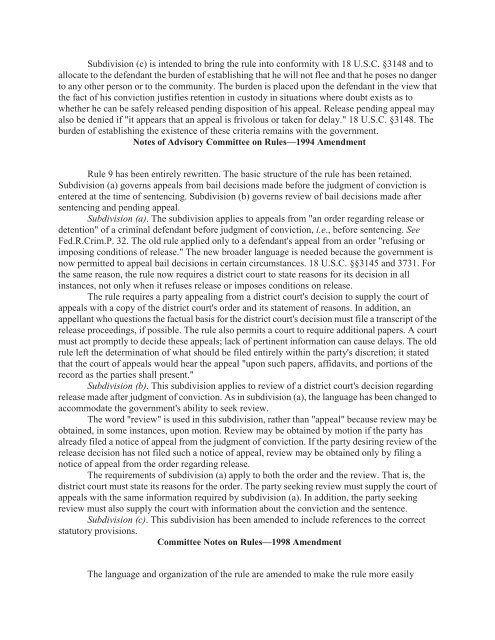Federal Rules of Appellate Procedure 2014-2015, 2014a
Federal Rules of Appellate Procedure 2014-2015, 2014a
Federal Rules of Appellate Procedure 2014-2015, 2014a
You also want an ePaper? Increase the reach of your titles
YUMPU automatically turns print PDFs into web optimized ePapers that Google loves.
Subdivision (c) is intended to bring the rule into conformity with 18 U.S.C. §3148 and to<br />
allocate to the defendant the burden <strong>of</strong> establishing that he will not flee and that he poses no danger<br />
to any other person or to the community. The burden is placed upon the defendant in the view that<br />
the fact <strong>of</strong> his conviction justifies retention in custody in situations where doubt exists as to<br />
whether he can be safely released pending disposition <strong>of</strong> his appeal. Release pending appeal may<br />
also be denied if "it appears that an appeal is frivolous or taken for delay." 18 U.S.C. §3148. The<br />
burden <strong>of</strong> establishing the existence <strong>of</strong> these criteria remains with the government.<br />
Notes <strong>of</strong> Advisory Committee on <strong>Rules</strong>—1994 Amendment<br />
Rule 9 has been entirely rewritten. The basic structure <strong>of</strong> the rule has been retained.<br />
Subdivision (a) governs appeals from bail decisions made before the judgment <strong>of</strong> conviction is<br />
entered at the time <strong>of</strong> sentencing. Subdivision (b) governs review <strong>of</strong> bail decisions made after<br />
sentencing and pending appeal.<br />
Subdivision (a). The subdivision applies to appeals from "an order regarding release or<br />
detention" <strong>of</strong> a criminal defendant before judgment <strong>of</strong> conviction, i.e., before sentencing. See<br />
Fed.R.Crim.P. 32. The old rule applied only to a defendant's appeal from an order "refusing or<br />
imposing conditions <strong>of</strong> release." The new broader language is needed because the government is<br />
now permitted to appeal bail decisions in certain circumstances. 18 U.S.C. §§3145 and 3731. For<br />
the same reason, the rule now requires a district court to state reasons for its decision in all<br />
instances, not only when it refuses release or imposes conditions on release.<br />
The rule requires a party appealing from a district court's decision to supply the court <strong>of</strong><br />
appeals with a copy <strong>of</strong> the district court's order and its statement <strong>of</strong> reasons. In addition, an<br />
appellant who questions the factual basis for the district court's decision must file a transcript <strong>of</strong> the<br />
release proceedings, if possible. The rule also permits a court to require additional papers. A court<br />
must act promptly to decide these appeals; lack <strong>of</strong> pertinent information can cause delays. The old<br />
rule left the determination <strong>of</strong> what should be filed entirely within the party's discretion; it stated<br />
that the court <strong>of</strong> appeals would hear the appeal "upon such papers, affidavits, and portions <strong>of</strong> the<br />
record as the parties shall present."<br />
Subdivision (b). This subdivision applies to review <strong>of</strong> a district court's decision regarding<br />
release made after judgment <strong>of</strong> conviction. As in subdivision (a), the language has been changed to<br />
accommodate the government's ability to seek review.<br />
The word "review" is used in this subdivision, rather than "appeal" because review may be<br />
obtained, in some instances, upon motion. Review may be obtained by motion if the party has<br />
already filed a notice <strong>of</strong> appeal from the judgment <strong>of</strong> conviction. If the party desiring review <strong>of</strong> the<br />
release decision has not filed such a notice <strong>of</strong> appeal, review may be obtained only by filing a<br />
notice <strong>of</strong> appeal from the order regarding release.<br />
The requirements <strong>of</strong> subdivision (a) apply to both the order and the review. That is, the<br />
district court must state its reasons for the order. The party seeking review must supply the court <strong>of</strong><br />
appeals with the same information required by subdivision (a). In addition, the party seeking<br />
review must also supply the court with information about the conviction and the sentence.<br />
Subdivision (c). This subdivision has been amended to include references to the correct<br />
statutory provisions.<br />
Committee Notes on <strong>Rules</strong>—1998 Amendment<br />
The language and organization <strong>of</strong> the rule are amended to make the rule more easily


















